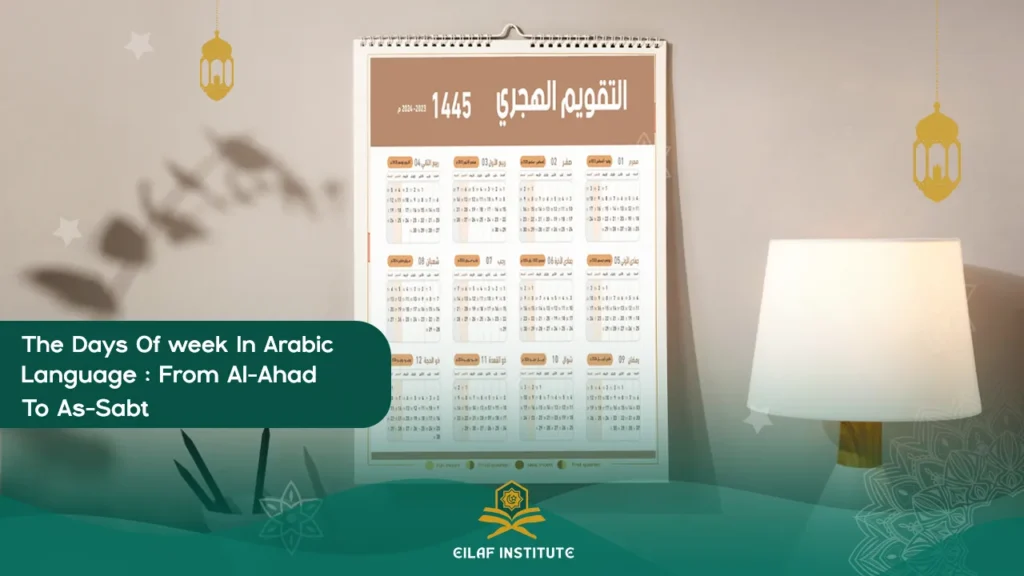Whether you plan to travel to an Arabic-speaking country, conduct business, or simply connect with the rich culture, learning the basic vocabulary is your first step. Among the most essential phrases to master are the days in arabic. This knowledge is fundamental for scheduling, making plans, and daily conversation. This guide provides a clear and comprehensive overview of the days of the week in arabic language, complete with accurate pronunciation to help you speak with confidence.
What are the days of week in arabic language?
With respect to English, the names of the days of the week are very different days of week in arabic language, Beginning with Sunday, the Arabic names for the days of the week are based on numbers.
The days of week in arabic language are listed below, along with their literal translations into English and their corresponding Arabic names:
- الأحد – Sunday: Literally translates to “The First”.
- الإثنين – Monday: literally means “The Second”.
- الثلاثاء – Tuesday: translated literally as “The Third”.
- الأربعاء – Wednesday: Literally, it translates to “The Fourth”.
- الخميس – Thursday: Literally translates to “The Fifth”, it often marks the end of the workweek in many Arabic countries.
- الجمعة – Friday: Derived from the verb “جمع (jama’a)”, meaning to gather, considering that it is the primary day for Islamic congregational prayers.
- السبت – Saturday: Originates from the Hebrew word “Sabbath”, reflecting the shared Semitic roots of Arabic and Hebrew.
Read also about: Can you listen to Quran while working out?
Days of the week arabic pronunciation in english
Below is a complete list of the Arabic days, their English translations, and a simple phonetic guide to help you with pronunciation. Notice how the names for Sunday through Thursday are derived from the Arabic numbers one through five.
- الأحد (Al-Ahad): Pronounced as “al-ah-had”
- الإثنين (Al-Ithnayn): Pronounced as “al-ith-nayn”
- الثلاثاء (Al-Thulatha’): Pronounced as “al-thoo-la-thaa”
- الأربعاء (Al-Arba’a): Pronounced as “al-ar-ba-aa”
- الخميس (Al-Khamis): Pronounced as “al-kha-mees”
- الجمعة (Al-Jumu’ah): Pronounced as “al-joo-moo-ah”
- السبت (As-Sabt): Pronounced as “as-sabt
Although these pronunciations are based on Modern Standard Arabic, keep in mind that Arabic pronunciation might alter between dialects and geographical areas.
Now, after knowing The Days Of Week In Arabic Language. Book now our online arabic classes
The Cultural Significance of Friday (Al-Jumu’ah)
Understanding the week days name in arabic also offers a window into the culture. Friday, or Al-Jumu’ah, holds special religious importance in Islam. It is named for the congregational prayer (Salat al-Jumu’ah) that Muslims gather for on this day. In most Muslim-majority countries, Friday is part of the official weekend.
The Days Of Week In Arabic Language: Tips for Memorizing the Arabic Weekdays
Effectively learning the days name in Arabic involves a combination of repetition, context, and interactive practice. Here are some proven methods:
- Use Flashcards: Create cards with the Arabic days in English on one side and the Arabic script and transliteration on the other.
- Listen and Repeat: Use audio resources to listen to a native speaker and practice repeating the names aloud to perfect your pronunciation.
- Create Associations: Connect the numerical roots (Ahad = 1, Ithnayn = 2) to help you remember the order from Sunday to Thursday.
- Practice in Context: Try to use the days of week in arabic in simple sentences. For example, scheduling a fictional meeting or talking about your weekly routine.
Explore the course :Arabic for Travel Course
Why Learning the Days of the Week in Arabic is Essential?
Mastering this basic vocabulary is a crucial step for any language learner for several key reasons:
- Fundamental for Conversation: Knowing the days is essential for making plans, discussing schedules, and having everyday conversations.
- Cultural Understanding: It provides insight into the cultural and religious rhythm of life in Arabic-speaking regions, especially the importance of Friday.
- Practical for Travel and Business: This knowledge is vital for scheduling appointments, booking travel, and understanding business hours.
- Builds Confidence: Mastering foundational vocabulary like the weekdays in Arabic builds confidence and encourages you to engage more deeply with the language.
- Improves Vocabulary and Memory: It serves as an excellent exercise for expanding your Arabic vocabulary and strengthening your memory skills.
Mastering the days of the week in arabic language is a fantastic and achievable goal for any beginner. It opens the door to more complex conversations and a deeper appreciation of the language. If you are ready to continue your journey, we invite you to explore the comprehensive courses offered at Eilaf.

